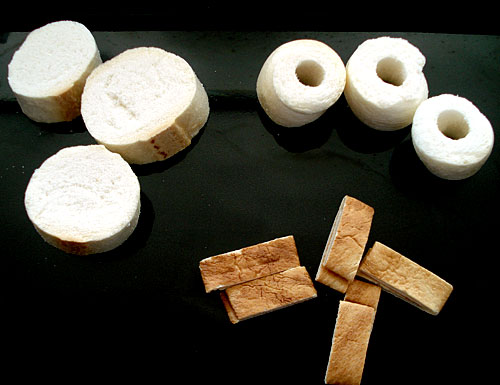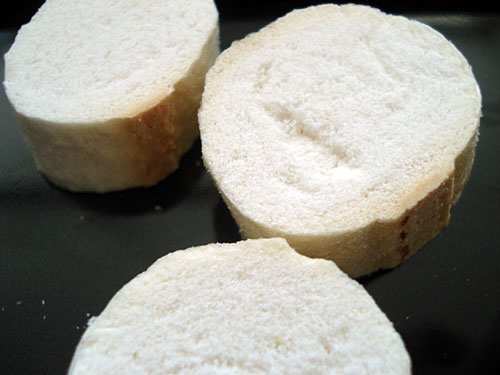Fu, the mother of seitan
Vegetarians are probably familiar with seitan as a meat substitute. Seitan is wheat gluten that has been kneaded in such a way that the gluten threads align themselves to resemble meat. It was invented by advocates of the macrobiotic food movement in Japan, specifically as a meat substitute, in the 1960s. (Fairly accurate (from what I've read elsewhere) Wikipedia entry.)
But way before there was a macrobiotic movement, let alone seitan, people in Japan were already eating a wheat protein product called fu (麩). Like seitan, fu is made from the gluten that is extracted from wheat flour. Sometimes the gluten is mixed with other ingredients. There are two kinds of fu: raw (namafu 生麩), which is basically fresh fu; and grilled and dried (yakifu or yakibu 焼き麩). Here I'd like to focus on the dried kind which is much easier to get a hold of for people outside of Japan. It's also a great pantry item, since it keeps for a long time.
How yakifu is made and types of yakifu
Yakifu is traditionally made by forming raw fu into various shapes, then slowly grilling it over a flame until barely colored on the outside and totally dried out. It has various names according to how it's made, and where it comes from. Here are three types of yakifu that I happened to have in my pantry:

From top left going clockwise, they are called komachibu, chikuwabu, and shounaifu. (Chikuwabu is called that because it resembles chikuwa, the fish paste product that's popular in oden.)
Here's a closeup of the komachibu, which is the kind that I find to be most versatile.

As you can see, it looks like little dried bread slices. That's because essentially that's what they are, except without the yeast and such.
Another kind of dried fu is kurumabu, wheel-shaped fu that are about the size of a doughnut. They are often used as meatless 'steaks' and such. I can't find kurumabu at my local Japanese grocery store, but you may be able to at yours.
Here is a map of Japan showing different kinds of fu and where they come from (Japanese).
A meatless protein
100 grams of dried fu has 369 calories, almost no fat and 28 grams of protein. So like seitan, it's a pretty good vegan protein. The only people for whom fu would not be suitable are those who are gluten intolerant. (Of course this applies to seitan as well.)
But what does it taste like?
On its own, dried fu is pretty tasteless. It's like a soft sponge that absorbs any flavors you can throw at it. The texture when dry is like stale bread, and when reconstituted it's soft and rather silky. If seitan has a texture a little like chicken, I'd say that fu, especially komachibu, is a bit like scallops.
How to use dried fu
The easiest way to use dried fu is to just throw some into a soup or stew. You may have already encountered them in miso soups. You don't have to limit it to miso soup though. Put some into a hearty vegetable soup, simmer briefly, and you have a fairly nutritionally complete meal. The komachibu and chikuwabu will taste like fluffy soft quenelles; the shounaibu is just a bit more dense in texture.
You can put them in in the last few minutes into a stew as well, meatless or not. If you simmer it for too long, it will start to disintegrate. (Shounaibu is more sturdy, since it's thinly stretched and folded.)
A slightly more advanced way is to reconsitute it first in plain water, then to stew it and so on. Fu is such a popular ingredient in sukiyaki that some people called dried fu sukiyakibu. Do remember though that the reconstituted sponge has no flavor, so you'll have to add it in by cooking it in a bit of soup or broth or sauce first.
Modern cookbooks have devised other ways of using dried fu; for example, Yumiko Kano, a cookbook author I've mentioned here several times before, uses komachibu as a base for mini-canapes. I haven't tried this myself yet but it's an intriguing idea.
As a first step though, try adding a few to a soup and see how it goes!
(And here's a panfried komachibu recipe over on Just Bento.)
Sidenote
Although fu is a very commonly available product, seitan is virtually unknown outside of macrobiotic circles in Japan. I actually didn't even know it had Japanese origins - I thought it came from somewhere in southeast Asia, like tempeh! It's ironic that seitan is much better known outside of Japan - maybe because it's used in things like Tofukey.
If you enjoyed this article, please consider becoming my patron via Patreon. ^_^

 Welcome to Just Hungry, where we serve authentic Japanese recipes and more! I'm
Welcome to Just Hungry, where we serve authentic Japanese recipes and more! I'm 













Comments
Ariel
6 March, 2008 - 16:57
Permalink
Great!
This is great- exactly what I wished for in the poll! : ) A couple of weeks ago, I made my own seitan (a fun afternoon project). I'll be looking for its "mother" on my next shopping trip...
tanja
7 March, 2008 - 07:53
Permalink
Thanx!
I am so happy you describd it here! I have tried several times fu, specially in Okinawan food (omelette with goya and fu) and loved it. I even bought some but don't really know how to use it. So thanx indeed!
Also, it is so educational to read about not so standard Japanese foods (although so common in Japan)
Maki, I have a question about ramen. I know that though it sometimes kontains no meat, the stock usually does. But in Hokkaido I have tried some excellent seafood ramen with simple fish stock or something.
Since I am a "fishitarian" I'd love to have some nice recipe for ramen without meat stock.
May be you can add that to your ramen collection.
BTW, I ma so greatful to your recommendation of "Tampopo". It was hilarious! It also increased my status among my Japanese friends, they were so surprised that any foregners would ever see this so japanese movie.
best regards,
t
BB
7 March, 2008 - 15:32
Permalink
Fu
The only trouble I've had with fu is sometimes if you have a big chunk in boiling hot soup, if you eat it without letting it cool you're in big trouble, because it sucks up the hot liquid and then squeezes it all over your tender tongue...
Or maybe it's just me being greedy :D
Deanna
9 March, 2008 - 00:12
Permalink
Online Stores?
Does anyone know of any online stores to buy this? Thanks!
maki
9 March, 2008 - 05:30
Permalink
try asking
Deanna, I've found a couple of links:
http://www.goldminenaturalfood.com/detail.aspx?ID=505 (for kurumabu, wheel-shaped fu)
http://www.naturalimport.com/shop_for_fu (various kinds of fu)
If you are in Europe Japan Centre carries komachibu and shounaifu the last time I checked.
Alternately, try asking the stores that do mailorder (start here for lists of tons of them).
Mitch
9 March, 2008 - 06:16
Permalink
Is this what I think it is?
When I was a child my grandmother used to serve me miso soup with little cherry blossom shaped and colored delights floating on the top. It started out like a cracker but quickly absorbed the broth and swelled into soft pillows. I never knew what it was called as I called it "the sakura blossom" things, lol. Is this one and the same?
maki
9 March, 2008 - 08:03
Permalink
Yep, the flower-shape fu is
Yep, the flower-shape fu is called 'hanafu' or 'kobanafu' ( 'kohanafu') (little flower fu).
John Spuler
10 March, 2008 - 04:44
Permalink
Recipe
Do you have any recipes for making fu?
Vinelady
12 March, 2008 - 20:45
Permalink
Fu - Mushroom shaped
After seeing you post I decided to try some out. I found some mushroom shaped fu. I have had alot of fun with this. I made them up with some dried Lobster mushrooms. It was great. Thanks.
val
19 September, 2008 - 23:41
Permalink
hmm
I like fu in soup a lot, so I totally appreciate your efforts to make it more widely known -- it's an excellent and tasty food -- but, hmm...
well, I know this is an old post, but I'm pretty sure you're mistaken about the invention of seitan being a 1960s japan thing. I am fairly sure chinese buddhist monks have been eating the stuff for centuries...
we call it mian jin :)
see, even wikipedia agrees with me! and everyone knows wiki is the source of all knowledge!
http://en.wikipedia.org/wiki/Wheat_gluten_(food)
maki
21 September, 2008 - 22:34
Permalink
There’s no doubt that
There's no doubt that wheat gluten was used as a food long before seitan in various parts of Asia, but from what I have read seitan was 'invented' by the macrobiotic movement in the 1960s, as a vegan protein food that fit into the whole macrobiotic philosophy.
(And I do hope you were joking about regarding Wikipedia as being a reliable source...)
val
26 September, 2008 - 19:03
Permalink
ahaha, sorry, I guess the
ahaha, sorry, I guess the excessive exclamation points were not enough indication of tongue-in-cheek? :p
I'm not well-versed enough in the history of vegan food to argue the point. you may in fact be right, but having consumed my fair share of both various types of chinese fake meat / mianjin and the stuff supermarkets sell under the name "seitan" -- it basically seems like there is no difference to me. if anything, mianjin products tend to have more variety in texture and taste, but afaiac it is all the same stuff prepared in slightly different ways.
it was my understanding, is all I wanted to say, that the name seitan was coined during that movement, but the actual food had existed long before. at this point I guess it becomes a question of semantics: how different does something have to be from a previously invented food to be considered a new invention?
my personal answer is: different enough for me to be able to tell when I'm eating it. the entire culinary world may disagree with me, who knows.
but hey whatever. I hope I'm not coming across as really nitpicky or anything; I am sort of in the process of cutting meat out of my diet right now, so this stuff just interests me a lot, and when I saw your post... well...
anyway thanks for all the helpful stuff you are always posting; I've tried some of your recipes, and they always come out delicious :)
BarbJ
27 September, 2008 - 00:37
Permalink
This is very interesting to
This is very interesting to me because I have a koi pond and one of the treats sold for them comes from Japan and it's called Manda fu.
It does look like little pink dried marshmallows and gets spongy when wet. Although the koi don't let it sit around that long! LOL
It's one of their favorite treats, and they go for it like they've been starving! But it's very expensive for a pet treat. If the fu for people is cheaper I may try to make some of my own.
And I'll have to try it myself! Thanks!
Audrey.
20 May, 2011 - 20:46
Permalink
Re: Fu, the mother of seitan
This link has Intro, How to Make and recipes for many japanese food items like freeze dried tofu, mochi and fu... http://www.mitoku.com/products/fu/index.html